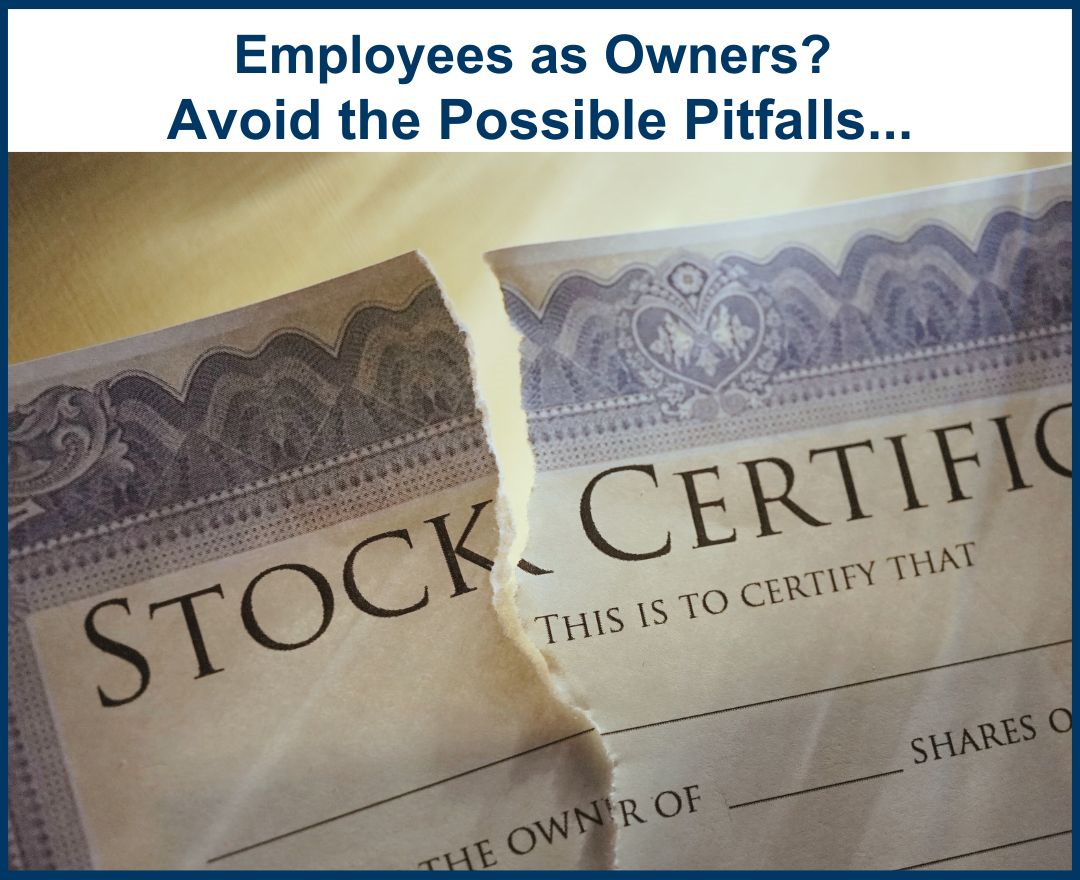Business owners often consider sharing ownership with key employees for one of two primary reasons:
1. Ownership succession planning.
2. Increasing the likelihood that key employees will stay with the company.

Initially, sharing ownership might seem like a wise, easy, and low-cost way to engage and retain key employees. If done carefully and selectively, this strategy can be effective. However, several potential pitfalls should be considered.
Potential Issues
Access to Information: Any business owner, regardless of their ownership percentage, has the right to access all financial and business information. Is the controlling owner willing to share such information?
Influence of Minority Owners: Even a small, minority equity interest grants the employee-owner a say in certain decisions, or at a minimum the employee-owner may have the expectation of such involvement. This is especially true if existing company documents require a unanimous vote for specific situations.
Employee Departure: If a key employee leaves, they remain an owner. This situation is rife with trouble if not planned for in advance. Always define how ownership interests will be handled if any employee-owner departs. Determine whether leaving employment requires selling back the ownership interest and if so, how this interest will be valued. For guidance on drafting such language in a buy/sell agreement, see our earlier blog on how to draft such language in a buy/sell agreement here.
Misalignment of Agendas: Differences in business agendas, purposes, or goals can lead to differences or even litigation. While the employee-owner may not control the ultimate decision, a dissatisfied minority owner can be a significant problem, causing internal strife or even potentially leading to dissenting shareholder legal actions.
Identifying the Right Employees
While identifying key employees is seemingly easy, filtering first for entrepreneurial drive is crucial. It is a matter of having that ‘fire in the belly’ to do what it takes to thrive as a business overall, beyond just being a strong employee at their job. Some considerations to determine if the employee is entrepreneurial include:
● Risk Management: How well does the employee deal with risk? Business ownership requires analyzing risk/reward and sometimes taking chances.
● Financial Literacy: Can the employee read and understand the financial statements?
● Tax Implications: Does the employee understand and accept the tax implications, particularly if the business is structured as a pass-through entity?
● Investment Willingness: Is there an understanding that sharing in the rewards of ownership (distributions) also includes the risk of needing to invest more equity should the business need it?
● Legal Commitment: Do all parties understand that this is a legally binding relationship? Quitting employment is easier than unraveling ownership, which can be complex and similar to a business divorce.
How to Do it Right
1. Filter for Entrepreneurial Drive: First and foremost, once a key employee has been identified, carefully consider and filter for the entrepreneurial factors noted above. While some aspects of business ownership can be learned, entrepreneurship is often innate. Efforts to make someone entrepreneurial rarely succeed.
2. Educate, Educate, Educate: While key employees may be very familiar with the day-to-day business operations they likely have limited or no experience in the realities of business ownership. Provide education or use your stable of business advisors to assist in providing such education to key employees. CapVal regularly offers free webinars on reading and understanding financial statements and the power of understanding the historical financial trends of the business rather than looking at a single year’s performance. The company’s accountant and/or attorney can assist with training on taxes, business structure, and existing legal documents. The business banker can provide an understanding of how the business utilizes debt and the personal guarantees that may be required.
3. Define Agreements: Work with business advisors to create a buy/sell agreement or other contract(s) defining the rights and restrictions of the equity interest and what happens if employment ends. You really only have one chance to objectively work through the various ‘what-if’ scenarios and get it defined in writing.
4. Skin in the Game: While increased compensation or bonuses can provide the cash flow for buying in, require key employees to source some portion of the equity cost themselves. This fosters a greater commitment and understanding of the investment’s risks and rewards.
Alternative Solutions
If the goal is to ensure longevity and commitment without sharing ownership, consider other options such as employment contracts, bonuses tied to goals, or stock appreciation rights (SARs).
Are you considering sharing ownership with key employees? Contact us for a complimentary discussion. Every business is unique, and we’ve seen a lot of businesses in our 50 years!

